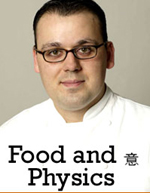Dr Vino's wine blog
wine talk that goes down easy
Bringing closure? A screwcap-cork showdown
Five years ago, Randall Grahm staged a funeral for the cork. The great marketer and label designer behind Big House Red and Ca del Solo among other brands staged a processional for his last cork at Grand Central Station of all places. From then on, all of his wines have been bottled “en screw.â€
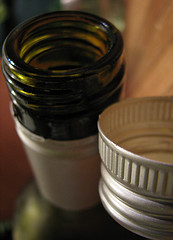 Since enjoying wine is in many ways a race against time (and oxygen), how a bottle of wine gets sealed is of utmost importance. Corks have their detractors since they can introduce the noxious chemical TCA that makes wines “corked.†Further, the pieces of tree bark can lose their elasticity as they age letting in wine’s nemesis, oxygen.
Since enjoying wine is in many ways a race against time (and oxygen), how a bottle of wine gets sealed is of utmost importance. Corks have their detractors since they can introduce the noxious chemical TCA that makes wines “corked.†Further, the pieces of tree bark can lose their elasticity as they age letting in wine’s nemesis, oxygen.
Screwcaps, by contrast, can provide such a tight seal that no oxygen gets in and there is no problem with TCA. Many proponents of screwcaps (or Stelvin closures, if you must) might suggest that the only thing standing between them and domination of the wine world is consumer resistance since wines bottled “en screw†have typically been seen as more downmarket. And what would you do with your $100 corkscrew if you only had to twist the cap off?
Screwcaps appear to be so controversial with their partisans for and against, you might think it impossible to find a producer who goes both ways. Fortunately the Wine Media Guild was able to find several examples of the same wines bottled under both closures for the March tasting.
Michel Laroche attended the tasting as speaker to share his experiences as well as several of his wines bottled under both closures. Laroche is a fifth generation winemaker from Chablis who has run his family firm since 1967 and now also makes wine in the Languedoc, Chile and South Africa.
For Laroche the transition to screwcaps started in 2001 when an unacceptably large amount of his wine was sold unknowingly with TCA that came through corks. Placing the estimate at 10 percent of his production that year, he expressed frustration because he said that consumers never complained so he didn’t know if they thought that flawed wine was actually his style.
So in 2002 he took action. He set up an alternative bottling line and bottled three percent of his production under screwcaps. He bottled the same day and from the same vats. He brought four of his wines that run the gamut of his line for us to taste, with a bottle under each closure.
The difference was shocking. Read more…
Creative cocktails: Q&A with Brian Van Flandern
Brian Van Flandern was the man behind the bar for three years at Per Se in New York. Now he’s on his own revamping the list at Bemelmans Bar at The Carlyle among other places. Since he’s a a pioneer of food-friendly cocktails and has made many a cocktail for wine lovers, I thought if anyone could talk to us about cutting-edge cocktails, he’s our man. I caught up with him earlier this week.
If you have a question for Brian, post it in the comments below! He has said he will respond to the three reader questions.
 Dr. V: Why should wine drinkers be interested in cocktails?
Dr. V: Why should wine drinkers be interested in cocktails?
BVF: It’s a fun time in cocktail history. Last year was the 200th anniversary of the word cocktail in print. But only in the last decade or so have we moved out of the Betty Crocker era. The top chefs are sourcing meat and vegetables from growers, taking advantage of the terroir–wine is all about terroir.
Mixologists caught up with chefs in the last three or four years seeking out fresh ingredients, making their own tonics and tinctures. Ironically it is cutting-edge but also a throwback to a pre-Prohibition philosophy, when bartending was highly respected. Bartenders took care in making cocktails and sourcing ingredients, even if it took a long time to get them.
Now the cocktail is coming back as a wonderfully balanced libation. Cocktails are approaching the alcohol levels of wine at around 20-25 percent alcohol by volume and not the 35-40 percent alcohol that people may be used to. The alcohol level comes down with ice melting, adding juices, mixers, you end up with a cocktail just above some wines in terms of alcohol—and food friendly too.
A new generation of master mixologists is emerging. Culinary students are bringing food sense to mixology, and we’re starting to see a very professional mentality. And, thanks to FedEx, we’re able to source fruits and spices and unique food products that we were not previously accessible. You can have Australian finger limes any time of year. Same with Buddha’s Hand. Even fresh pomegranate juice was not available 5 yrs ago. Litchi, rambutan—these are all new flavor profiles.
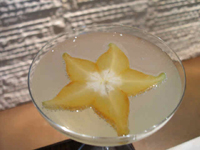 A lot of times cocktails are just too sweet. Why? And what can a drinker do about it?
A lot of times cocktails are just too sweet. Why? And what can a drinker do about it?
Yes. During Prohibition they were making high alcohol cocktails that were very poorly made. They threw a lot of sugar in there. The goal was to get schnockered before the cops busted down the door.
Reunite on ice was the bomb back in the day. So was box wine. But we have witnessed how wine has changed in the past 20 years. Now not only do we have cabernet sauvignon, but also gruner veltliner, tocai friuliano and so on.
Cut back to cocktails. They were all booze coming out of Prohibition—think Manhattan, martini, and Rob Roy. Then in the 1970s, there were the ice cream cocktails, the blended and frozen umbrella drinks. There were even sweet liqueurs like Kahlua, Frangelico, and Bailey’s. If a cocktail is not balanced, people can balance their own by requesting either a simple syrup or lemons and limes from the bar.
Now we’re latching on to the lessons of pre-Prohibition and applying what we have access to today.
Sounds good to me. What’s a red flag for people to know if the bar is not in this new generation?
Look around. In almost any bar, somebody is drinking a cosmopolitan. If it is clear, if it is red, I would be hesitant. If it is cloudy, bubble gum pink I would be intrigued.
Or ask “How do you make your cosmopolitan?†If they say they use Rose’s lime juice–get out! Run!
No fresh juices? That’s a red flag. If you listen and you don’t hear the “thwacka thwacka†of the shaker more than three times, that’s another red flag. Shaking drinks provides dilution, a nice texture and reduces the alcohol level.
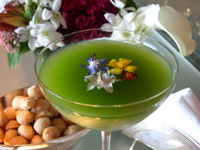 So what are the basics of making a cocktail?
So what are the basics of making a cocktail?
Start with the base spirit—1 oz to 1 ¼ oz. Then add the modifiying spirit—just for flavor, like vanilla extract in cooking, not for alcohol–¼ oz to ½ oz. Then add mixers—fresh juices, soda water, cola, and so on. Incrementally build the cocktail. The mixer is going to provide sugar or acid–if you use a mixer of Sprite, add some lemon or lime to balance that out. If you’re using orange juice, it’s high in sugar and acidity and may not need anything else. Lime juice is tart needs simple syrup or, say, pineapple juice.
Acid, alcohol and sugar, that’s the mantra. Balance in proper proportion.
Flavored vodkas: is there one worth buying?
Yes, but I always use flavored vodkas as a modifying spirit. The vast majority of them have a very chemical finish. They smell wonderful–just like lemon, raspberry and so on–but you always wince on the finish. They should be used in moderation as a modifier not as a base. I also don’t mix vodkas made from different base products such as wheat, potatoes, barley—I use the same base vodka and the same modifier.
What’s the best vodka for making mixed drinks?
I like Ciroc with juices because it is distilled from grapes. But I don’t care for Ciroc as a traditional martini vodka. Belvedere is good and crisp. It’s from rye and is viscous, has more glycerin. For olives, I like rye vodkas.
The cosmopolitan was born as a promotion for Absolut Citron.
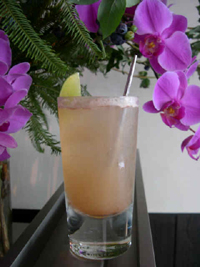 When you were at Per Se you made your own tonic water for your “tonic and gin� What’s your beef with Schweppes?
When you were at Per Se you made your own tonic water for your “tonic and gin� What’s your beef with Schweppes?
Ha. Mass produced tonic water uses a quinine derivative, which is assertive in flavor. In an effort to balance it they use high fructose corn syrup. I use raw quinine powder in its natural state, which is much less sugar by volume. I should add that the HFCS is in American tonic water—I’ve had Schweppes in Spain that is delicious.
All right, rapid fire now. What are the top ten cocktails that people should know how to make at home?
1. Sidecar — a classic and very tasty
2. Margarita
3. Negroni
4. Aviation
5. Daiquiri/Hemingway daiquiri
6. Manhattan
7. Classic martini—gin or vodka
8. Mojito
9. Cosmopolitan
10. Bloody Mary-–actually quite a complicated process
What’s the most useful tool for the home cocktail maker?
A juicer! Fresh juice is so important.
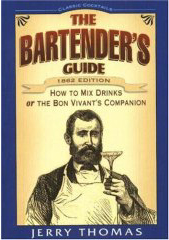
What are some good cocktail reference books?
Craft of the Cocktail: Everything You Need to Know to Be a Master Bartender, with 500 Recipes, by Dale DeGroff
The Joy of Mixology, by Gary Regan
The Bartender’s Guide on how to mix drinks (1862 edition), by Jerry Thomas,
Killer Cocktails: An Intoxicating Guide to Sophisticated Drinking, by David Wondrich
When can people come visit you at Bemelmans Bar at the Carlyle?
I’ll be there with all new cocktails—and none of those ten I mentioned—as of March 20.
What’s the most underrated cocktail?
Brandy Alexander
And finally, if you were exiled to a desert island and could have one last cocktail, what would it be?
A sidecar.
Related:
MyMixologist.com, Brian Van Flandern’s web site
“Riding sidecar with Brian Van Flandern” [Dr. V]
Lake Wobegon wines
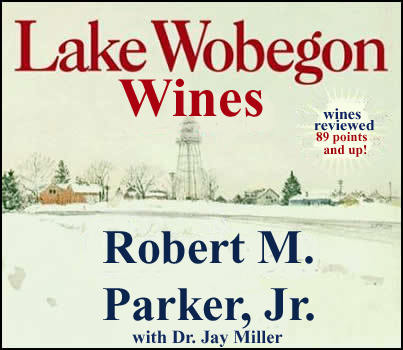
In the pages of BusinessWeek, Robert Parker calls some under $20 wines from Gallo, Beringer, and Kendall Jackson “very good” to “excellent.”
Meanwhile, in the main arena of the Parker Empire, the Wine Advocate, his new hire Dr. Jay Miller handed out high scores like candy–including five 100-point scores–to Spanish wines.
Is Robert Parker’s world turning into an enological equivalent of Lake Wobegon where all the wines are above average?
XO XO from Cognac with love
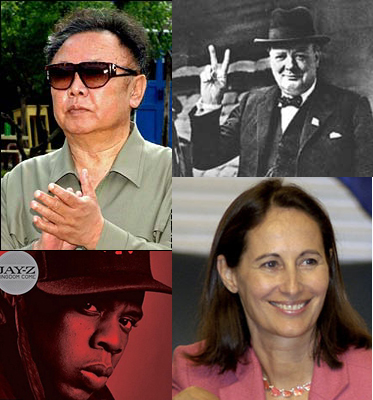
Winston Churchill. Kim Jong-Il. Jay-Z. Segolene Royal. What’s probably the one thing they have in common? Cognac!
With fans as diverse as this, how could I not know more about this distinctive beverage? Samuel Johnson threw down a challenge to us wine geeks more than 200 years ago when he was offered a glass of claret. “No, Sir, claret is the liquor for boys; port, for men; but he who aspires to be a hero must drink brandy,” according to Boswell.
Well, I don’t know if I aspire to hero status, but I’m not going to settle for being a mere “boy!” So when the Bureau National Interprofessionnel de Cognac, the trade group representing ALL producers and distillers in the region invited me on a press trip, how could I refuse?They asked me what I know about cognac. I said nothing. They said, “Fine!”
 So what do I know about cognac? Let me think out loud:
So what do I know about cognac? Let me think out loud:
- Like Champagne, Cognac is both a drink and a place. Fancy that. It’s north of Bordeaux, touching the Bay of Biscay and runs inland.
- Also like Champagne, Cognac favors brands over growers. That’s evidenced by the fact that the cognac Hennessey is the best known wine and spirits brand according to Business Week magazine. And the second? Moet.
- Cognac is made from grapes! The humble ugni blanc is grown with yields almost three times that of quality table wines. Then it is distilled. Twice.
- Production is 95% exported.
- Hip-hop artists want to “pass the Courvoisier.” Cognac is also known as “yak.”
- One cognac comes in a Baccarat crystal bottle and costs over $1,000.
Actually I do know one more thing: there are various grades of cognac. Here’s my initial impression, pending further research:
- VS = blending
- VSOP = blending or sipping
- XO = sipping, big bling factor
For the late, great R. W. Apple Cognac, “properly made and aged, is the best brandy in the world.” The decisive factor in setting cognac apart from other brandies is not the unique climate or soil. Appple ascribed its difference to the humans, saying “the decisive factor is the skills in distilling, blending and maturing that have been perfected over 300 years.”
But with almost all the production exported, looking at who and where it is consumed is arguably just as important as where it is made. In his excellent story “Cognac and its Cognoscenti” in the Wall Street Journal last June, Eric Felten wrote about the rich history of brandy and American musicians, particularly African-American musicians such as Billie Holliday or Dexter Gordon all the way to P-Diddy. Felten observed this change:
With Lady Day and Dexter, cognac was a way to cultivate and project a worldly, savvy and civilized image. By contrast, the hip-hop brandy trend has been more about sheer expense — especially the stuff that sells for four figures and comes in Baccarat bottles. Even so, I suspect that cognac’s appeal to the hip-hop crowd is about more than conspicuous consumption. The authors of the “thug” lifestyle seem to think a glass of cognac is like “a gat in the hand.” Rap’s celebration of yak is an embrace of the venerable notion that cognac is the drink not only of the rich, but of the powerful.
How open are the cognac producers to this embrace? After all, when the Economist asked a representative of Roederer about the house’s top wine, Cristal, being a favorite of the hip-hop crowd he made comments that were interpreted as racist and led to a boycott of the bubbles.
It seems to me that the cognac producers are likely more relaxed about their “cognoscenti.” Their beverage is, after all, a distillate, potent and concentrated. They’re used to blending or just playing it straight.
So next week I’ll be reporting on this and more from the region. I hope to be able to post from the region but that depends on two things. First, internet access, which can be spotty in France. And second, if I can keep my tasting volumes below the “heroic” levels of Churchill.
What I’m reading to get up to speed on Cognac:
Cognac, by Nicholas Faith (2005, Mithcell Beazley)
Cognac, the Seductive Saga of the World’s Most Coveted Spirit, By Kyle Jarrard (2005, Wiley)
“From the Thinnest of Wines, the Richest Spirit: Cognac,” R. W. Apple, NYT, September 25, 2002.
“Cognac and its cognoscenti,” Eric Felten, WSJ June 3, 2006
Cognac-world.com
Cognac.fr, the BNIC site
PS bonus points for anyone who can say who Segolene Royal is. And double bonus for why she is relevant to cognac!
Tasting sized pours – Dr. Vino edition
For those of you new to the site–and those of you just dying to look in the rear view mirror–I compiled this roundup of some notable posts on the blog in 2006. Things that you frittered away your time reading when you probably should have been working on a spreadsheat–or better yet, drinking wine!
 Goose Gitmo, I suppressed my gag reflex and visited a foie gras goose farm in France.
Goose Gitmo, I suppressed my gag reflex and visited a foie gras goose farm in France.
Cantu feel the love tonight, I crossed swords (laser beams?) with Chef Homaro Cantu of Moto restaurant
Meeting Michel Rolland: The controversial winemaker’s jet touched down in NYC; I listened and tasted.
Quality guaranteed? Does recorking older wines guarantee quality or commit adulteration?
Malbec, a backup or a star? I found a midpalate and more in Mendoza.
Mourvedre, the next big red? It’s big. It’s wild. But is this grape ready for the big time? I tasted ten wines to find out.
The best affordable wines you’ll never have this fall
Grower champagnes: a lunch with importer Terry Theise
Dear Jorge Ordonez, please bring us a good box wine.
Grapes on the half-shell: Steve Smith, a New Zealand wine maker, basks his grapes in reflected glory.
No monkeying around: A biodynamic wine maker in South Africa who makes an excellent syrah–and keeps the baboons at bay.
I got the poop on how to make compost.
I ventured off the beaten path to join the Wine Century
Give the gift of big red…and a roundup of memorable wines of 2006.
Bordeaux, Bordeaux, Bordeaux! You’re probably sick of hearing about it. Posts ranged from new language on labels, to price insanity, an export turnaround, the bottom of the barrel, urban sprawl, and finding good values among the rising prices.
A bipartisan meal? Yes, I got a jump on what must now be more common in DC.
I brought wine on a plane and made a screenplay about it. That’s not true–that was the snakes. But it was a happy ending in my story since the wine didn’t break.
Last year the Supreme Court made it easier to buy wine directly from wineries. So why is it so hard to buy from some out of state stores I wondered?
Jay-Z flashed a new champagne. But is he behind it?
Should wine be sold in Massachusetts’ grocery stores? I argued yes. The voters said no.
Wine shop madness! Find favorite shops from other bloggers in the WBW roundup. I even visited a few wine shops in Paris. And I kept an eye on the NYC retail scene visiting Bottlerocket, Moore Brothers , and the new Astor.
In fact, I visited more than that and plotted an interactive map of NYC wine shops. Four more maps followed, all listed on the sidebar.
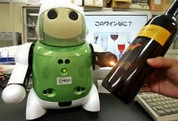 Who’s on notice?
Who’s on notice?
Wine tasting robots
Cider
United Airlines
Chef Homaro Cantu
David Sinclair bites the grape that feeds him: resveratrol researcher admits “I don’t care about red wine.”
And some excellent guest posts:
Taste the terroir of the Marlboro Man, visiting Utah’s wineries
Gallo invents valleys, defines statewide terroir
A wine after its time, how to make vinegar and more with leftover wine.
You certainly had your say with comments, but here they were directed at the TSA.
But enough looking back! Onward to discover new wines and good times in 2007!
NY Sun sets on 2006
In a story in today’s NY Sun, I was quoted as saying that a memorable wine for me was the Hofstatter pinot nero 2005. True enough. But you already knew that. Newspapers have space limitations that don’t apply here on the web. So let me mention a few more!
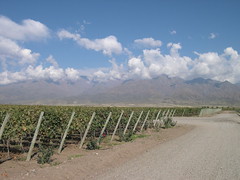 If I had to choose one wine to sum up 2006 it would be the Clos de los Siete 2004 (find this wine). Yes, I’ve mentioned it before and I don’t want you to think that it was the only wine I drank last year (I actually tasted over 2,000!), but it encapsulated the year in a bottle for a variety of reasons.
If I had to choose one wine to sum up 2006 it would be the Clos de los Siete 2004 (find this wine). Yes, I’ve mentioned it before and I don’t want you to think that it was the only wine I drank last year (I actually tasted over 2,000!), but it encapsulated the year in a bottle for a variety of reasons.
I visited Argentina in April of this year and I went to the dramatic Clos de los Siete winery. The vast project of over 2,000 acres was mere scrub brush in the late 1990s. Michel Rolland led a team of six other investors from Bordeaux. The wines under the Clos de los Siete name are the collaborative wine but the goal is that each investor will produce wines individually as well (I like the Cuvelier des Andes, 2004, about $30, find it). On a further personal note, I had the opportunity to meet Michel Rolland and taste through some of his wines with him.
Beyond these personal experiences the wine encapsulates 2006 in other ways. In a sign that wine and Argentine wine in particular is starting to reach the masses, TIME magazine declared Argentine malbec as “hot” in their year-end issue. Beyond being mostly malbec, the Clos de los Siete is a further sign of the times. It’s about $15, which is the new $10. And it is a big, bold, extracted, high-alcohol, wine and doesn’t seem particularly age-worthy.
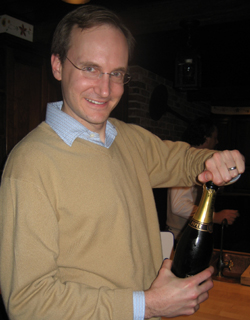 I’ve enjoyed many other wines this year. I sprung for Savennieres early in the year and explored the other wines of the Loire later in the year. I tossed back some torrontes. I tasted some amazingly vibrant older whites from Austria. Some pinot noirs from around the world moved me and I was particularly thrilled with the quality of Oregon pinot. I learned a lot about biodynamics and tried an excellent wine that had been protected from marauding baboons by lion dung. And found some good value Bordeaux. I wondered whether mourvedre and malbec, traditionally backup singers, had star power. And my year-end bubbled with some farmer fizz from boutique growers.
I’ve enjoyed many other wines this year. I sprung for Savennieres early in the year and explored the other wines of the Loire later in the year. I tossed back some torrontes. I tasted some amazingly vibrant older whites from Austria. Some pinot noirs from around the world moved me and I was particularly thrilled with the quality of Oregon pinot. I learned a lot about biodynamics and tried an excellent wine that had been protected from marauding baboons by lion dung. And found some good value Bordeaux. I wondered whether mourvedre and malbec, traditionally backup singers, had star power. And my year-end bubbled with some farmer fizz from boutique growers.
I look forward to sharing many more fun wines with you in 2007, either together offline at one of my classes or meet-ups or through the virtual vicariousness of the web. Cheers!
 tags: wine | 2006 | clos de los siete
tags: wine | 2006 | clos de los siete
Cantu feel the love tonight
I recently put Chef Homaro Cantu “on notice” for his wine service recipe published in Wired magazine. In brief, the avant-garde chef suggested zapping a vanilla bean with a laser beam to create a rich smoke that is trapped in an upside-down wine glass. Turned right-side up, the wine is added and the aroma is enhanced. Or so Cantu argued in the comments of my previous post (see here for full details). I was skeptical and gave him a proverbial wag of my finger and posted that I wanted my wine the way its maker intended.
I wrote Chef Cantu that I would be in Chicago over Thanksgiving and would be willing to drop by his restaurant, Moto, and give the “caramelaserized†wine a shot—or perhaps a zap. Here was his reply.
Mr. Colman,
We are closed on Sundays and on Thanksgiving. Please go to motorestaurant.com for hours of operation. Just let me know when you would like to join us and you will be my guest.
Thanks,
HC
A couple of emails later, and Chef Cantu told Mrs. Vino and me that we had a 5:30 reservation on Saturday. Zap, pling zoom! We were going to put this laser beam to the test.
The evening had an arc that it is best told in three scenes: anticipation and exploration; the encounter; disappointment and the bitter finish.
Scene I
Even though it was only 5:30, it was dark. Mrs. Vino steered our fire-truck red rental car through the canyon of dormant delivery trucks. Fulton Market used to house a portion of Chicago’s famed meatpacking district. Today the meat warehouses are giving way to loft office space, condos, and trendy restaurants, such as Moto.
I thought it would be the large and open restaurant on the corner with the headless mannequins in the window. It turned out to be the smaller restaurant next door, its windows shrouded in soothingly neutral colors blocking the view from the street.
The restaurant itself is not large. The sleek minimalism and color neutrality of the décor is occasionally disrupted by a cutaway to the brick wall underneath in an elegant nod to the neighborhood’s warehouse tradition.
We had read about the edible menu beforehand so when we were presented with the wine list on a small paper booklet, I was tempted to take a bite. But the dinner menus arrived shortly afterward and they were indeed printed with soy ink on some sort of edible paper grafted onto a flatbread seasoned with thyme and parmigiano reggiano. The choices were three prix fixe menus of five, ten or twenty (!) courses. The time estimates were one-and-a-half hours, three hours, or four hours. Yikes.
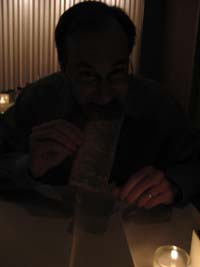 “When you’ve made your selection, signal to me that you’re done by taking a bite,†our server told us, a line that we heard repeated at other tables throughout the evening.
“When you’ve made your selection, signal to me that you’re done by taking a bite,†our server told us, a line that we heard repeated at other tables throughout the evening.
I told her that Chef Cantu had invited us so I wasn’t sure what he had in mind. While she ducked out to check, I tucked into my freshly baked menu, starting at the bottom with the copyright notice. Mmm, yummy copyright notice. (Note me doing just that in the low-lit photo to the right. Also note the ban on flash photography that rendered the food photos useless. That–and the fact that I kept eating the food before remembering to take a photo–doh!)
Our server returned to clear the menu crumbs and tell us that the chef had taken care of us. We didn’t know what we were getting in for. We wondered how long we would be there and if we should call my brother and tell him to put our son three-year-old son to sleep. But we couldn’t call since the menu said that cell phone use is prohibited. At least I think that’s what it said and I wasn’t about to summon it from the recesses of my digestive tract to find out.
First came a “soup and salad,†red and green liquids presented in the same bowl, a shaped vaguely like a gravy boat. The server said it was “pizza and Caesar salad.†The red side was “like we took a Domino’s pizza and blended it.†Ditto the green side with a salad. There were even mini croutons floating on the green side. The server poured us a Unibroue Editions 2005 ale from Quebec, weighing in at 10 percent alcohol, to accompany this dish (find this beer). Served in a wine glass, in the three sips of the short pour I noted a fun malty taste. Wacky as this course was, it worked. Though talking about Domino’s, which I hadn’t had since I last lived in a dorm room, wasn’t exactly what I wanted to be talking about here.
Second was hamachi sashimi with baby arugula, celery root puree, and some delicate, crunchy onion slices. Next to that was half an orange, face up, and bubbling. The server explained that it was “carbonated†and recommended trying a little of the sizzling foam and then squeezing it on the hamachi. I really liked the hamachi on its own. Verdict: sizzle over substance. The wine for this course was a dry white wine from one of my favorite producers, Baumard, in the small Savennieres sub-region in the Loire. (find this wine)
The third course was the best dish of the evening: monkfish served over scarlet runner beans (think fava beans but red) both pureed and whole. As the puree drizzled to one end of the oblong plate, it encountered some lively crunchy rice and a white powder. This was a form of truffle oil vinaigrette—dehydrated. It is a brilliant dish. A bite of fish dipped in the bean puree and the powder tasted as if it were washed in a rich sauce. The Vina Alberdi 2000 bottling from one of my favorite Rioja producers, La Rioja Alta accompanied the dish. With a notable presence of American oak in the wine aroma, the wine is serious particularly for its middleweight retail price of around $17. (find this wine)
It was about here that the loud guys at the table next to us ordered a “blueberry smoothie.†They asked the server to describe it and first one and then another server couldn’t. “I’ve never tried it,†said one. At this level of dining, I would expect that every member of the waitstaff had tried everything—or at least could say what it’s like everyday language if not the terms of molecular gastronomy.
Scene II
Our server approached the table and said that we were going to be escorted down to the kitchen—but first she had to return with the appropriate attire. Attire? I remembered hearing that when the restaurant first opened that the waitstaff wore lab coats (now they were black suits). She returned and placed some goggles on the table.
“These you can’t eat. But you have to put them on, either here in the dining room or at least by the time you get to the staircase in the back,†she said.
We did as we were told. We were escorted down the stairs to the kitchen. It was hot. And dark. Despite that all the kitchen staff were wearing sunglasses. A red flashing light, like one from a police car, cast a rotating red aura around the kitchen.
The pastry chef, Ben Roche, received us. He flicked a switch making a red beam appear on the floor. “Don’t cross this line,†he said retreating behind a machine that I took to be the class IV laser.
Just then a stocky, smiling figure, wearing sunglasses and headset with a boom mic sidled up next to me. “Hey, do I look familiar?†he asked. It was HC! Behind the dessert chef was a large screen with a grid of numbers along the column and the rows and color coding the middle. It probably managed the flow of each table’s meal. But it soon disappeared and was replaced with my blog. Precisely, the page where I put Cantu “on notice.â€
“Hey guys,†Cantu called to the kitchen staff. “Here’s Dr. Vino and here’s what he wrote about me!â€
Yikes. I had the feeling I was about to be thrown on the table in front of the laser beam like James Bond in Goldfinger. Fortunately Cantu was smiling. And the kitchen staff was too busy to even notice, let alone wield their knives in my general direction. The screen flipped back to his grid and we turned our attention to the laser.
Unlike the Wired recipe with a vanilla bean, our wine was to be “caramelaserized†using a sort of dehydrated orange, reduced to mere powder. Ben Roche, the pastry chef who was wearing a Bjorn Borg-style headband, held a spoon similar to a sweet-and-sour soup spoon with the powder of orange in it. A wine glass was clamped upside down and as the laser beam hit the spoon, a plume of smoke drifted up into each glass. Roche took the smoke filled glasses down and placed them on a small, cloth covered tray.
From behind her set of goggles, Mrs. Vino asked them if they had the largest pupils from working in such a dark environment with sunglasses. They replied that they just did it when there were visitors in the kitchen. Hmm, style over substance?
Our smoke filled wine glasses met us back at the table where they were up-ended and then filled with Tulocay Nord Family Vineyard 2002 pinot noir from Napa (find this wine). I had vaguely heard of this producer but never tried the wine so I asked for a pour in a glass that wasn’t “caramelaserized.†The wine in the treated glass was much more aromatically expressive—it amplified the wines rather muted aromas without seeming artificial. There was a predominant note of burnt orange, one that you would never find in the wine, but somehow it didn’t seem out of place. I anticipated the wine served this way would be simply gimmicky but instead I thought it was a neat trick, though not one I’d like to repeat with every glass.
This wine was paired with our fourth course, a pan-seared (how conventional!) quail from Texas. Although this was the bird that Dick Cheney was hunting during his ill-fated adventure, I somehow doubt that he’s ever eaten it off of Chef Cantu’s “battleship†plate—complete with patent pending we were told. The slab of steel has a 90 degree bend in the middle of it so it looked as if Mrs. Vino and had each taken out a laptop.
Chef Cantu is clearly an innovative guy and protruding out of the top portion of the plate were a spoon and a fork. Each had a sort of corkscrew handle. Fresh sage leaves had taken shelter there. With each bite, these “aromatic utensils†wafted sage under my nose. It might seem gimmicky but it worked.
Scene III
With the turn toward a series of sweet dishes, style started to trump substance. The “banana split†was doomed by the frozen “marshmallow†of maraschino cherry. Yes we all ate the maraschino cherry in a Shirley Temple, but how old were we then? The “doughnut forms†was certainly innovative since it involved doughnuts in five forms, none of them round. But in the final analysis the doughnut soup still tastes like a doughnut anyway. And pitching one of the morsels as “Dunkin’ Donuts blended with coffee†just wasn’t a thrill to me at this level of dining.
The “nacho chile†should have been the first dessert served since it blended sweet and salt of tortilla chips. Instead of ground meat, cheese and chili on the chips were covered with chocolate shavings, mango sorbet, and kiwi chunks. And the final petit four of silver dollar pancakes—cooked fresh in the kitchen, then liquefied, and dispensed through a turkey baster onto a frozen griddle, with dry ice clouds pouring off it—melted too quickly in my spoon and just kind of tasted like pancake batter. Along the way there was a Elio Perrone, Sourgal, a moscato d’Asti that was pleasantly sweet and bubbly (find this wine). This was the most generous pour of the evening at about 2 ounces.
During the quail course I had sent a follow-up question down to the chef. Sadly, it didn’t seem like he was going to reply during the meal because the server was signaling the end by asking us if we needed a taxi. We were busy debating how much tip to leave on a complimentary meal and we assumed this taxi question was the classic sign off for the end of such a meal. I stepped away from the table to see if the men’s room was as avant garde as the cooking. It wasn’t.
When I returned, I saw there was an envelope on the table. Assuming that it was a reply to my question that I had sent to the chef, I opened it to see his answer.
I was shocked. It was a bill for $237.26.
We were charged for two five course tasting menus and one wine service of $45. Plus tax and an 18 percent gratuity.
Suddenly it seemed way overpriced and not that much fun. In retrospect, Mrs. Vino joked that I should have put the bill in my mouth and then walked out smiling, having literally eaten it. What, the bill, unlike the menu, is not edible?
I was worried about the ethics of taking a free meal in the first place. In announcing that I would be going to Moto, I posted that I would be the guest of the chef to keep everything above board and that the sacrifice would—ha ha—be for you, dear reader.
But in the end Chef Cantu decided to spend my money without letting me in on the decision. The server could have informed us when we were ordering that the chef was happy to invite me to a wine service. Maybe we would have just had wine for one that way? Maybe we would have had the caramelaserized wine and hit the road? When I got the bill, I couldn’t help but think that we could have gone to another fun restaurant for half the money at a time we chose with wines that we had selected.
But then again, the bill is always the hardest thing to swallow.
Related:
“Who’s threatening us now? Homaro Cantu”
“We know there’s smoke–but how about mirrors?”
Moto restaurant
Malbec, a backup or a star?
As I headed to Mendoza, I was haunted by a couple of sentences Eric Asimov recently wrote from a Wines of the Times tasting panel on Malbec:
“…words came readily enough to sum up the tasting — two-dimensional, narrow-gauge, simple. Nothing wrong with those words, but not very many thrills among them.”
Chilling stuff for the traveler to Malbec Country! I didn’t really understand what “two-dimensional†meant but it certainly sounded like damning with faint praise. When I was on the ground, I put the question to Manuel Louzada, winemaker at Domaine Chandon. His reply came with a sketch on his tasting mat, which I attempted to recreate here:
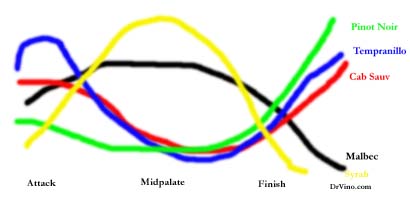
Essentially he said he could understand such a criticism because Malbec has a good attack and very good midpalate while it trails off at the finish. (If you think an attack is a military or a soccer term you’d be right; in wine tasting it also means how the wine tastes when it first enters your mouth—besides wet).
The other various arcs show the profile of other grapes. Tempranillo (blue, above) has a good attack, weaker midpalate, and a strong finish. Cabernet (red) has a similar arc he suggested but not quite as much on the attack. Syrah (yellow) has a broad midpalate but is kind of weak on the attack and the finish. Pinot Noir (green) has a finish that goes on and on—when done right.
This explains why some of the most expensive wines from the region are blends. The $70 Cheval des Andes 2003 (find this wine), perhaps my favorite of the big boy “grand cru†wines I tasted in Mendoza, is a blend of Malbec and Cab to give it a full style. Paul Hobbs added 5 percent Cab to his $100 Magadalena Toso (find this wine). And the $85 Nicolas Catena Zapata 2002 (find this wine) is a 72-28 blend of Cab and Malbec. This makes sense since Malbec has traditionally been a blender in Bordeaux and the Loire. Looking at the graphic above, a blend of the red and the black lines hits all the highs.
“The force of the Cabernet is softened by the Malbec,” José Galante winemaker at Catena said. “We make the best wine that we can in the Nicolás Catena Zapata.”
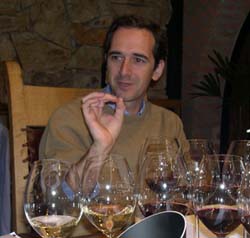
The various vineyard sites also have different tasting arcs for the same variety Galante said (see my notes on tasting Menodoza’s terroir). He works to blend those and give the single varietal wines more heft and character.
But what about Malbec on its own? “Malbec is sexy, it seduces,” said Manuel Louzada of Chandon. Indeed, this traditional backup singer is ready for a starring role. The prolonged growing season for the grapes in this high desert, which can have 50 percent more growing days than cool Bordeaux, makes the tannins in the Malbecs from Mendoza sweet and approachable. For white wine fans who object to the dryness or mouth-chomping tannins in Cabernet, reach for a Malbec from Argentina and you will not only have a wine that is easy on the palate but also easy on the wallet. If Malbec wines are two-dimensional, then the world is flat.
